 "QUANTUM SHOT" #317 "QUANTUM SHOT" #317link It was the Largest and Most Expensive in Soviet Space Exploration History - a grand effort and a noble, if not fully realized, dream The frustrating end to this titanic program (it was canceled in 1993 due to the political situation and a lack of funding), and some resemblance of "Buran" to the American space shuttle, make it easy to forget the impressive results that it achieved: a fully operational line of shuttles with one (unmanned) space flight in 1988 and the development of the huge "Energia" launcher, which is fully capable of lifting 200 tonnes into orbit and delivering a payload to the Moon. Click to enlarge most images 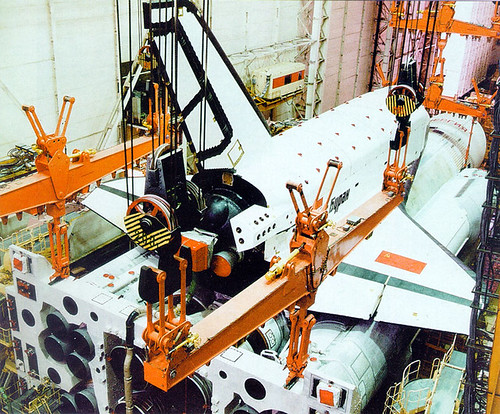  In other words, this program was something to behold while it lasted. Here we present rarely seen photographs of the various stages in "Buran"'s development and its trial flights, compiled from numerous Russian sites, including the most authoritative Buran.ru. 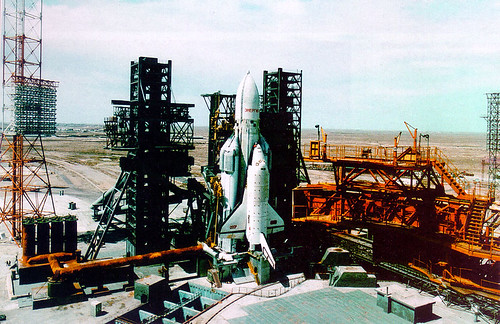  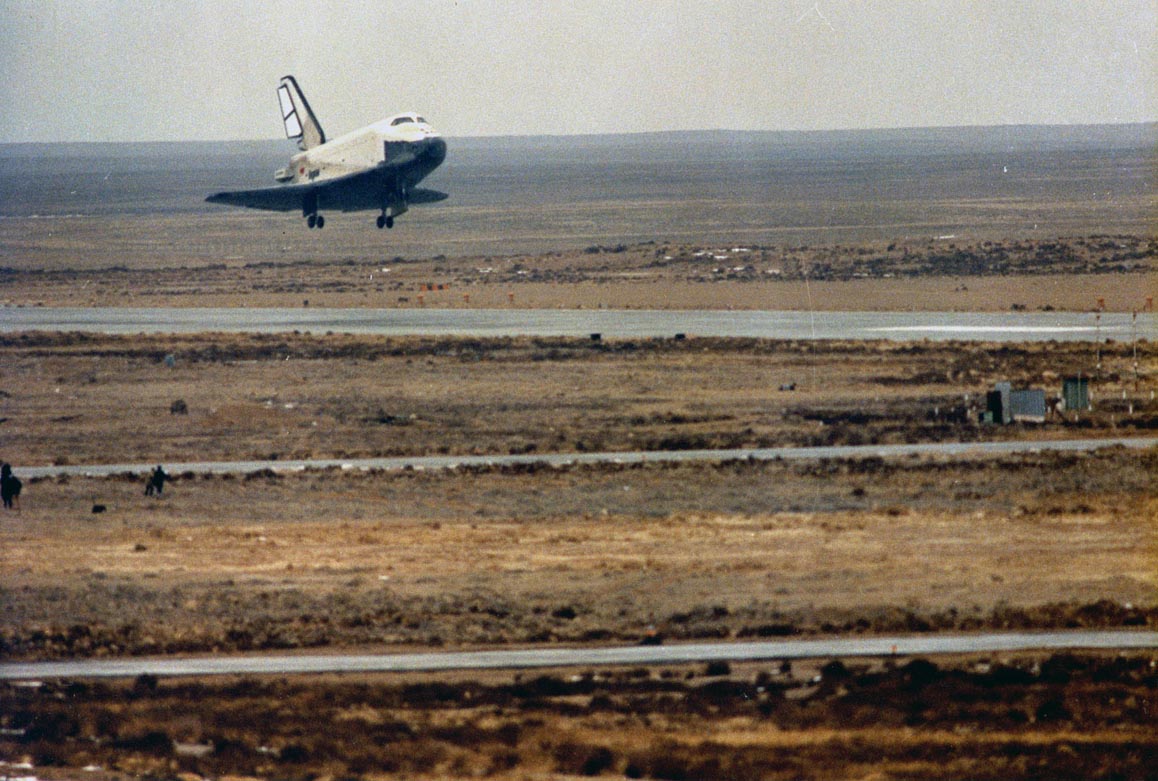 (images source: Ochevidec) The exterior of "Buran" and Space Shuttle "Columbia" may look similar, but that's where the similarities end (it's easy to imagine that communist spies only managed to photograph a few early airframe designs). "Buran" was just a payload for the Energia launcher (with many other types of payloads possible). "Buran" had automatic landing capability and, being a well-behaved robot, landed itself in 1988 without any problems. "Buran" carried by AN-225 "Mria" - an impressive combination 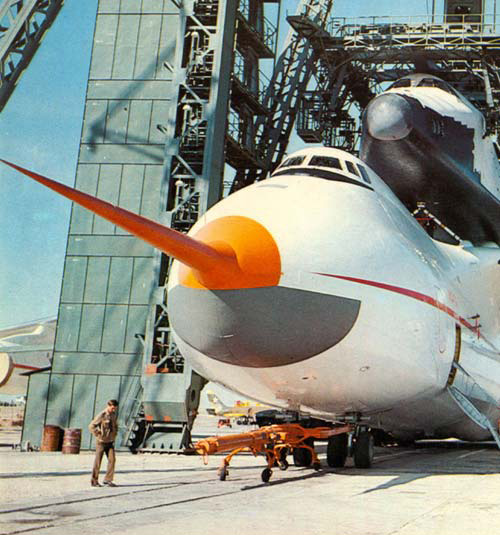  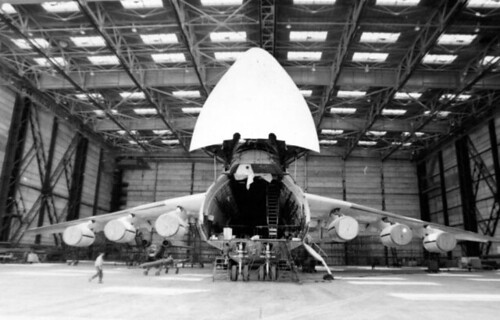 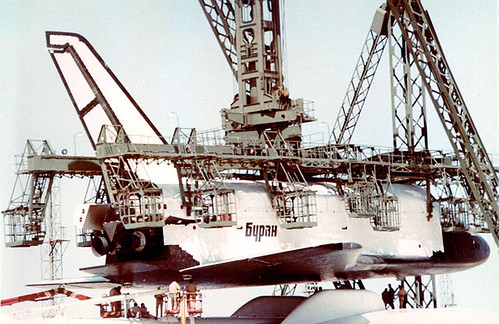 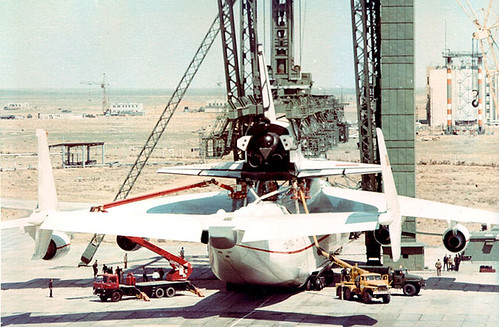 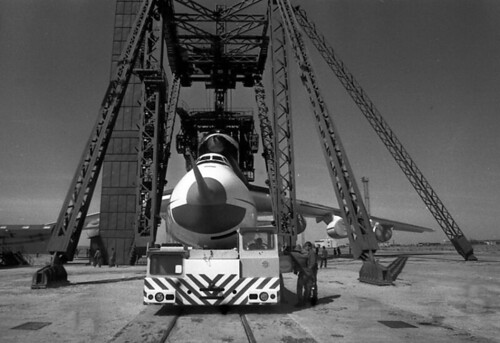 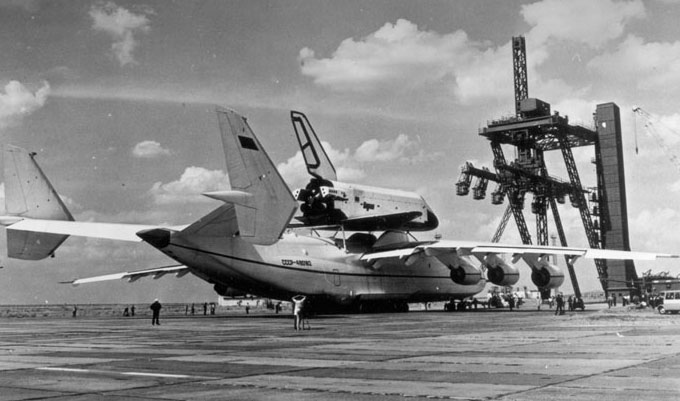 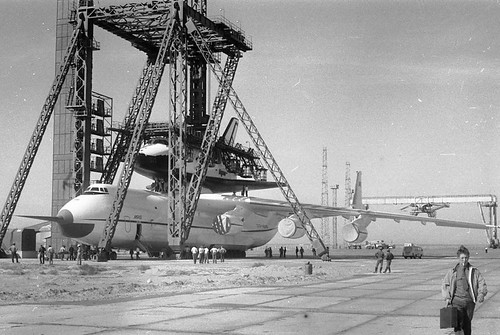 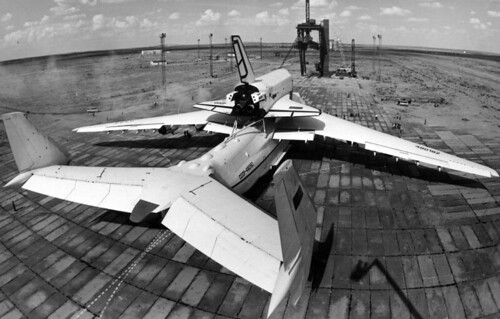 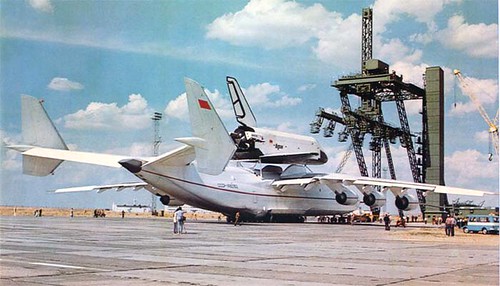 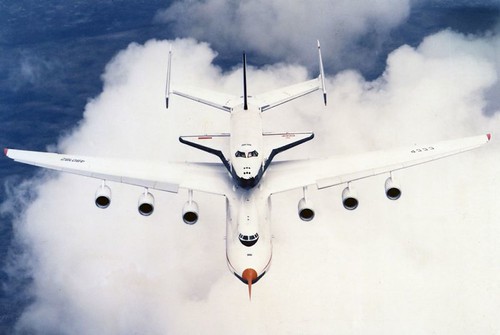 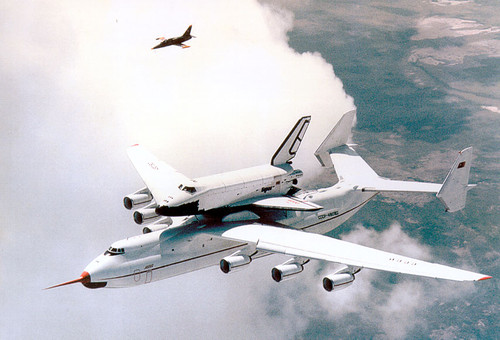 The heroic pilot team: 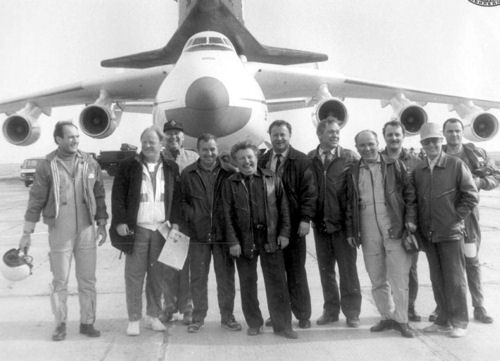 Some "Buran" close-ups: 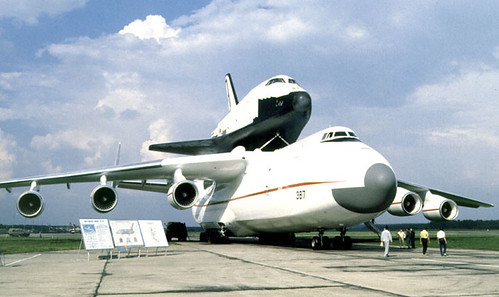  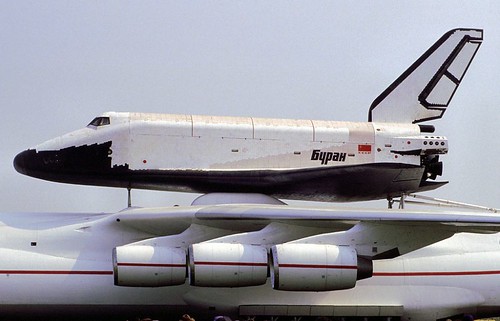 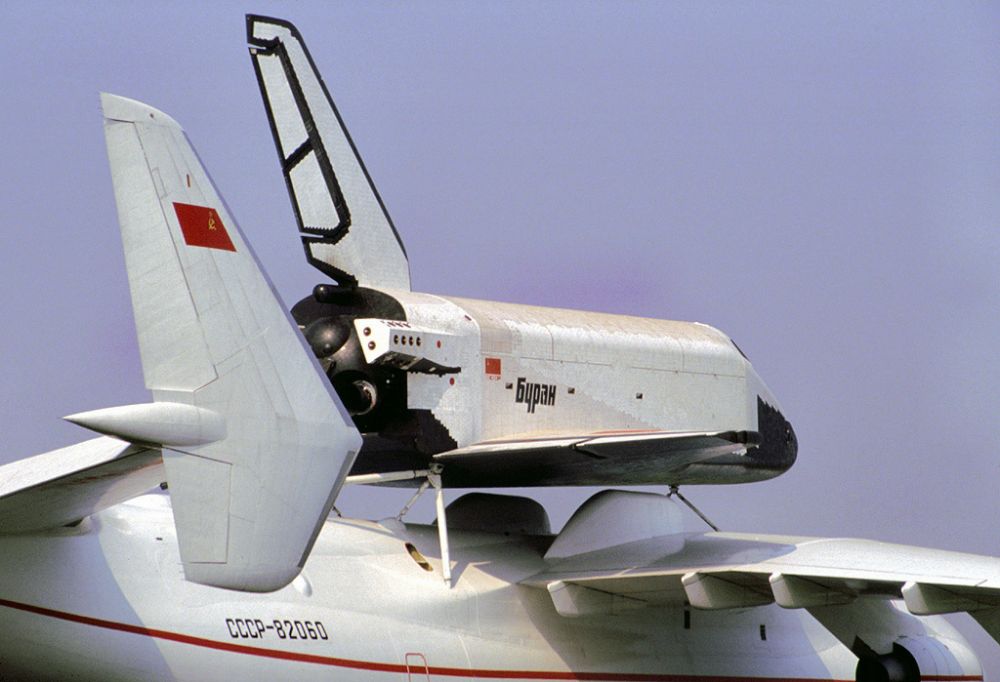 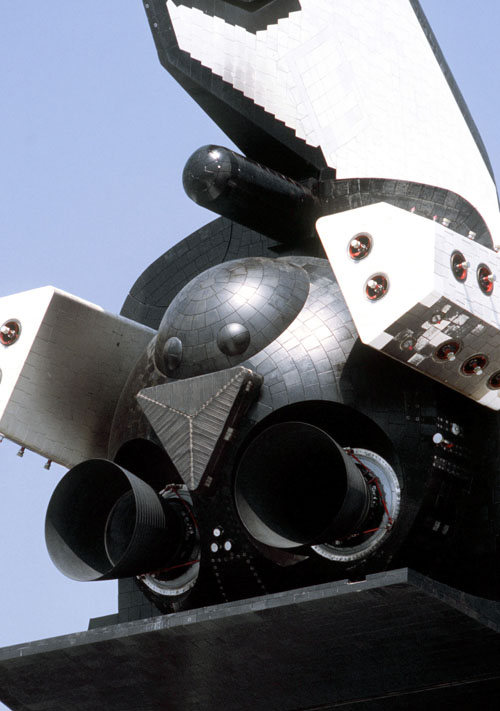 "Buran"'s cockpit Climb inside to experience rickety-looking Soviet computer panels and monitors. It takes guts to fly into space with these...   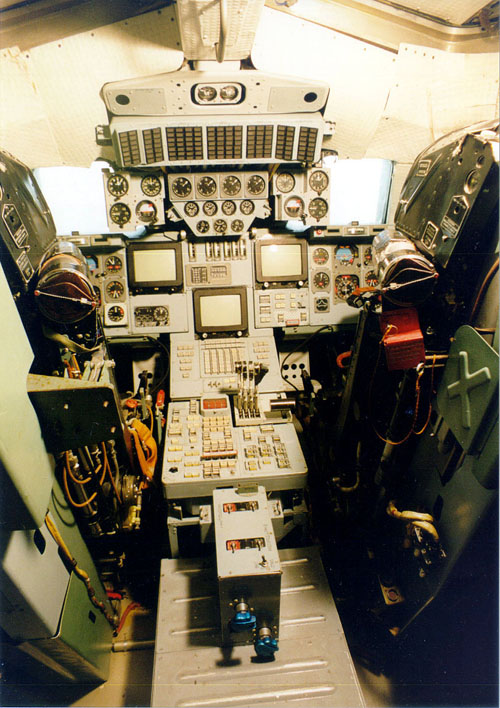 (images credit: Vadim Lukashevich) Early Concepts of Russian Space Planes There is some talk about "Spiral" orbital aircraft systems, conceived in the 50s and 60s; see many other images on this page. Some concepts are also shown on this page (in Russian). However there is definite information and existing models of the "Burya" system, (first concepts appeared in 1954) Read more here. 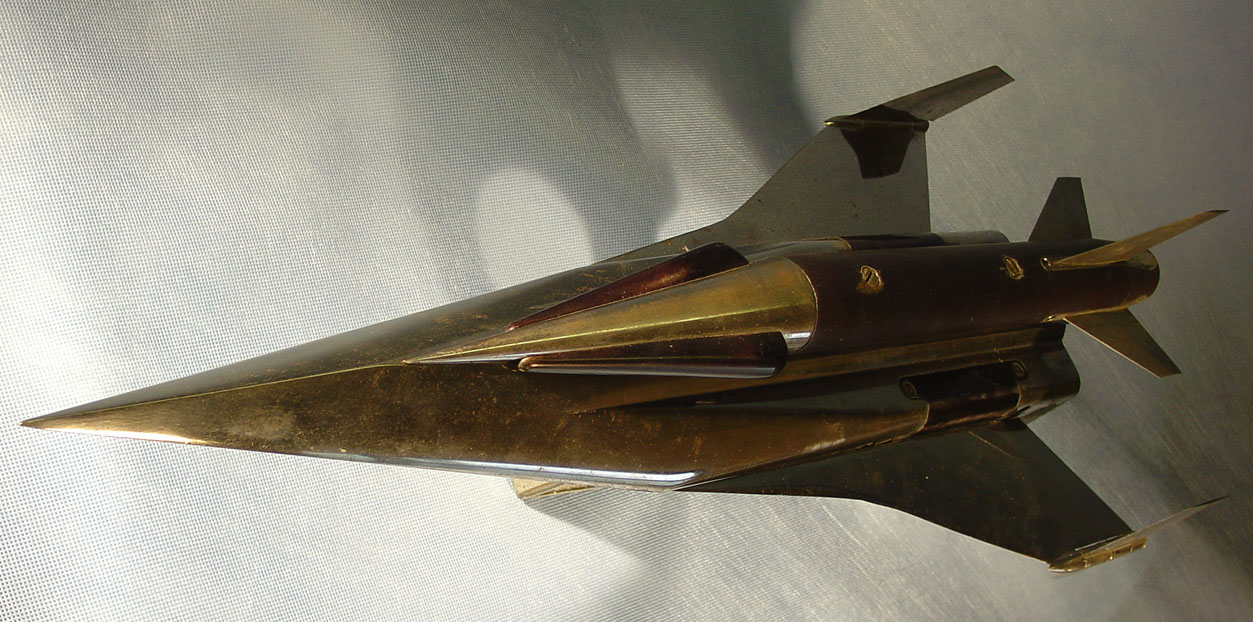 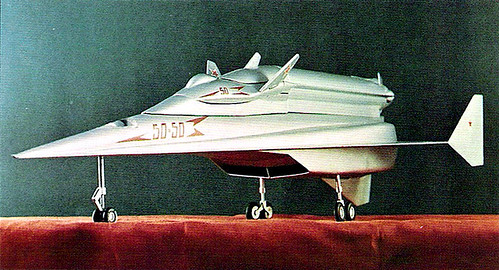 Early "Buran"-like model, made for the aerodynamic testing:  Published in early "popular science-like" magazine in Russia were concept and plans of an orbital plan, similar to the American ideas at the time:  (art by Nikolai Rozhnov, TM) Various early test of transporting spacecraft and hydrogen tank by air, using customized "Atlant" airplane: 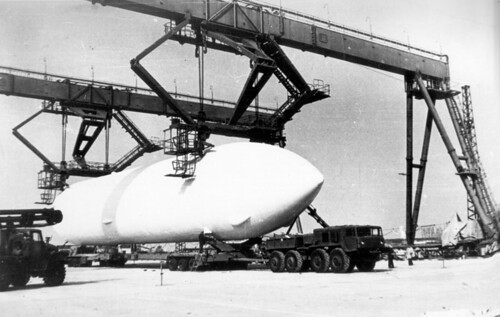 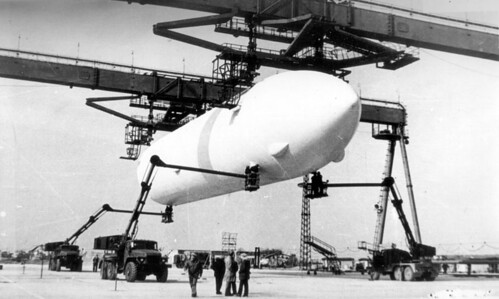 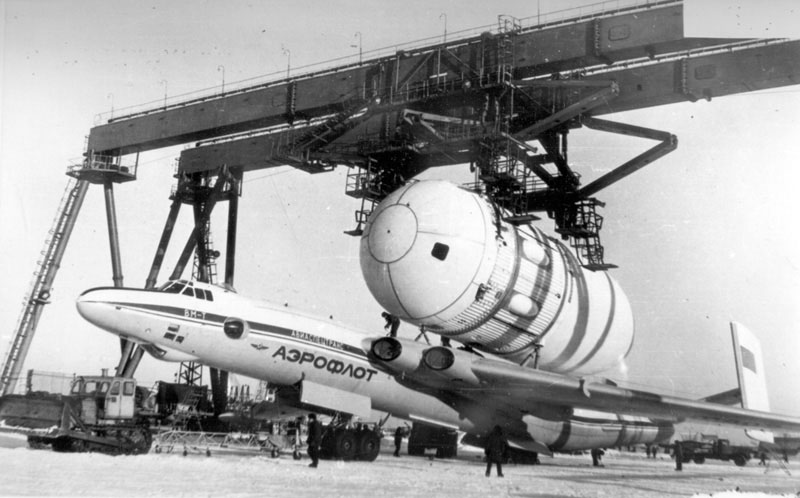 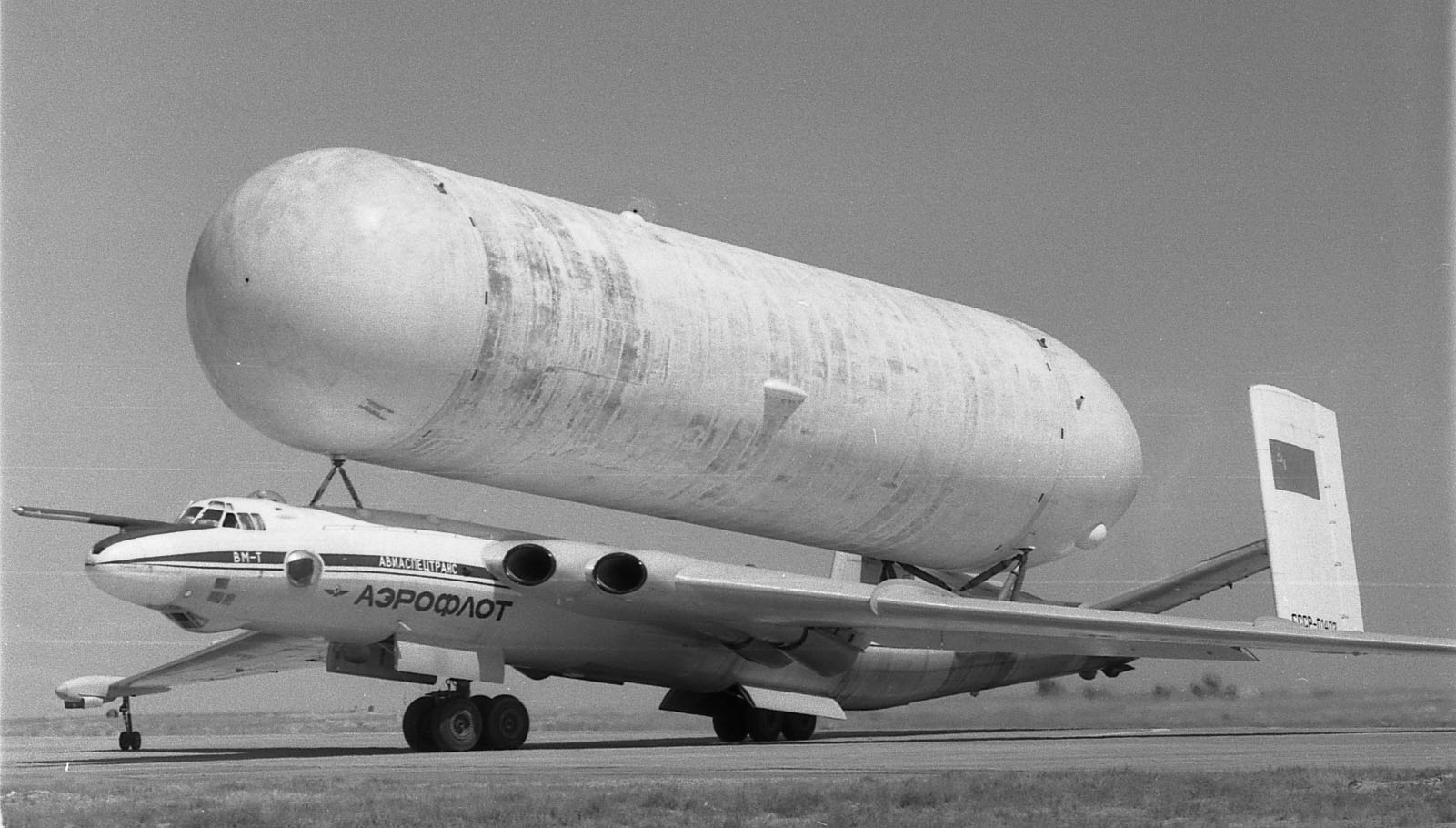 (images credit: V. Burdakov and S. Grachev) "Energia" launching complex I have to admit, this shot looks like a frame from a Cold War-era sci-fi movie: 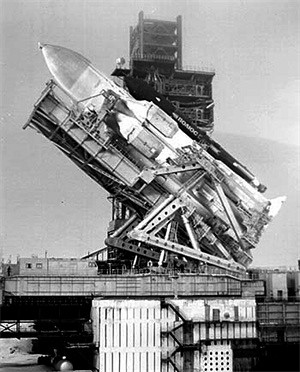 But actual reality (in 1983) was far more fascinating (these great photos are from the book NPO "Energia", see more here) 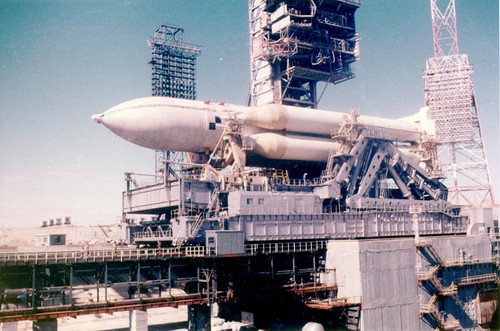 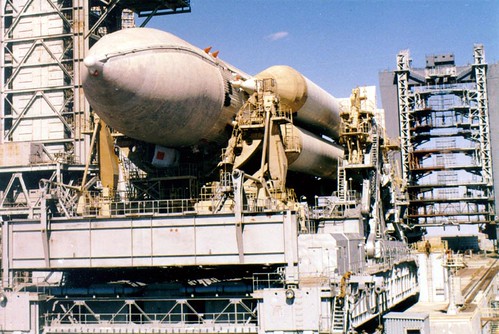  Locomotives pull the shuttle and the rocket to the launching pad for the communist's first flight to Mars (just joking)  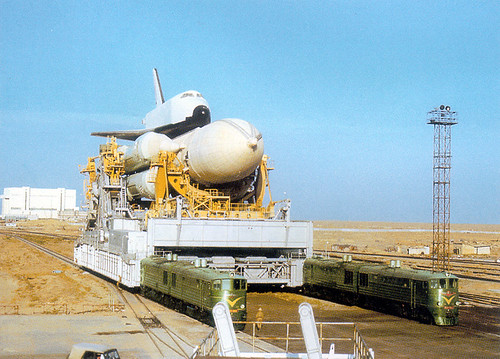 Apparently, bringing out the orbiter horizontally, pulled by locomotives, and then standing it up at the launch pad is much faster than American way of transporting the shuttle already erected. Energia-M 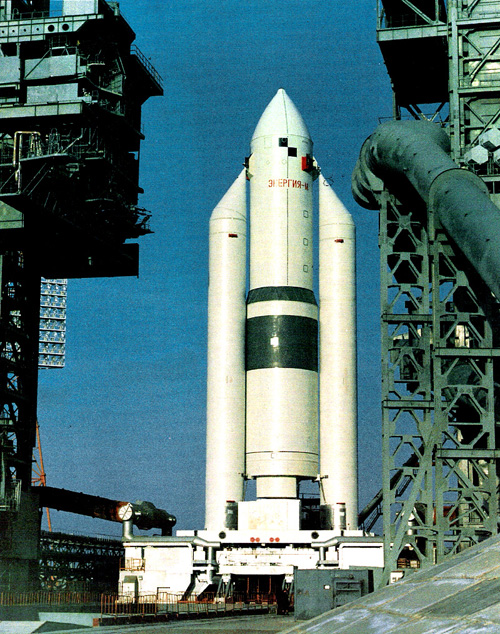 (image credit: "Cosmonautics - A Colorful History" ed. by Dr. Wayne R. Matson) Do I see some rusted pipes out there? You need more than the usual amount of good luck in Soviet Russia: 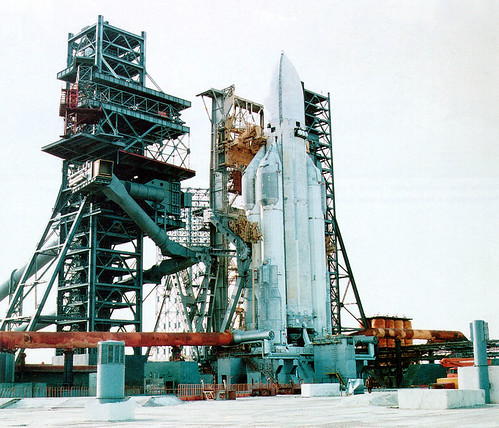 Pre-launch moving of "Buran" and "Energia" on rails 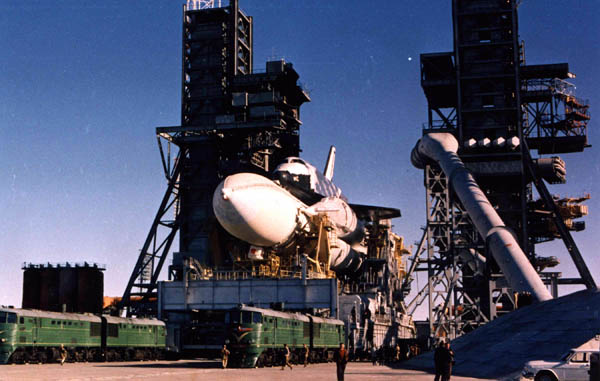  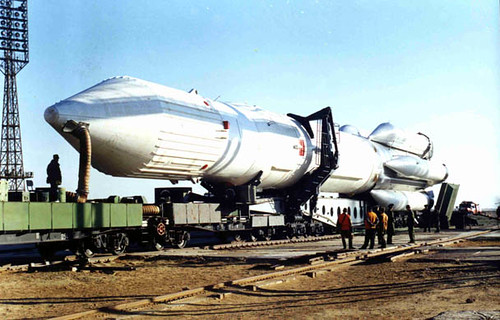  Flight of the "Baikal" (top secret or elaborate hoax?) The same Buran.ru site maintains that there has been yet another flight of "Buran"-like shuttle, called "Baikal", performed in utmost secrecy on February 4, 1992. 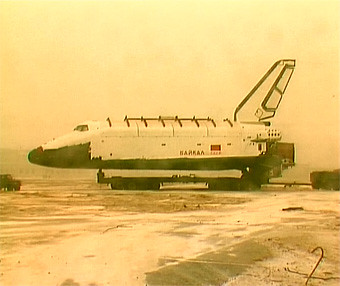 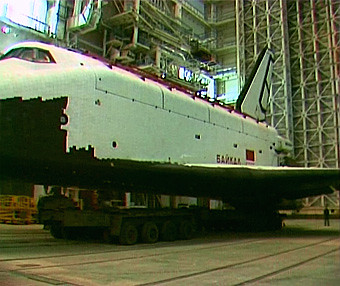 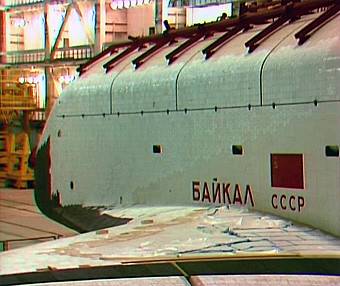 According to them, there is an interesting story associated with the naming of these ships. Everybody knows that "Buran" means a snowstorm. "Baikal", however, was the originally intended name for the program, scrapped in fears that some of the letters will burn out on landing and transform the name into "Baika" (which means a fairy-tale, untrue story), or even worse, into "kal" which means simply "crap". With "Buran"'s successful flight in 1988 these fears were put to rest, so "Baikal" again became a viable monicker. It's also worth mentioning that the projected future ships would also bear stormy names - like "Hurricane / Uragan" and "Typhoon". Original flight plan included meeting with "Mir" space station, but the ship did not go all the way into orbit. There were problems with stabilization and at 100 km altitude "Baikal" was turned back and successfully landed, ending its 22-minute flight. 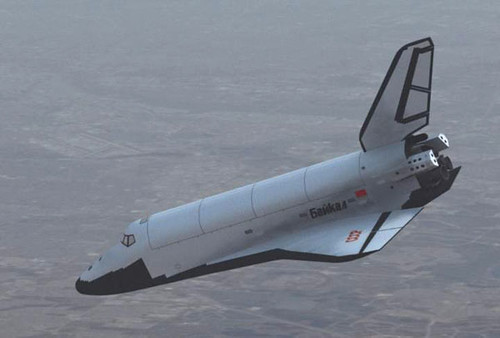  The following two pictures are simulated:  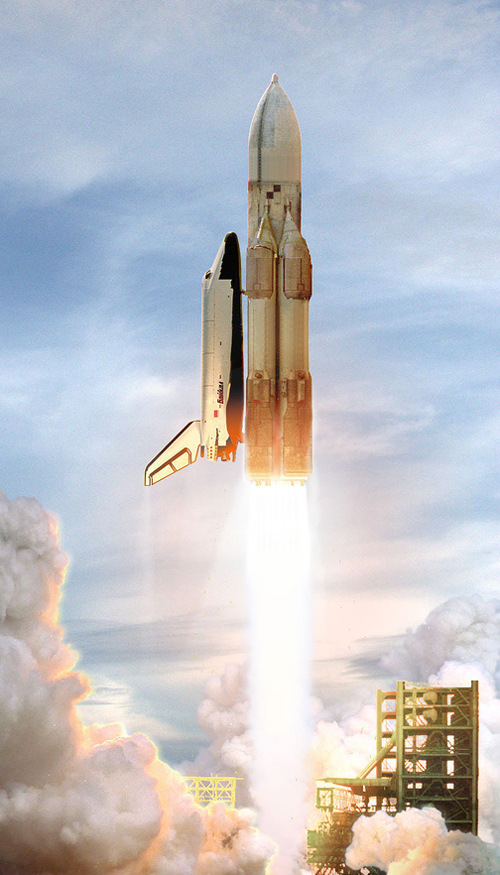 (images credit: Vadim Lukashevich) There is a healthy dose of controversy surrounding these facts, bearing in mind the utmost secrecy of the attempt. However, even if the flight did not actually take place, the program continued well into the 90s and amazingly, was not even officially closed... just abandoned. You see, it takes some significant funds to properly mothball/close the program, and of course all the funds were already gone. The "Buran" program had a chance of resurrection in 2003, when all US shuttles were grounded, but the equipment and infrastructure were already dismantled or re-purposed, leaving the whole the idea in sad abandonment to this very day. This "Buran" is mothballed in storage, most of the others are effectively destroyed. 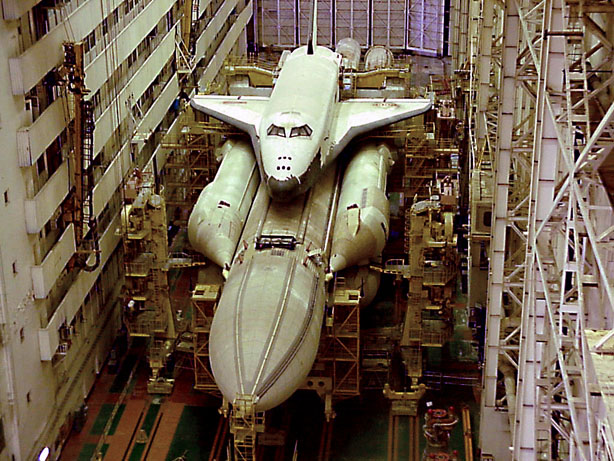 The ultimate sad story, I can't look on this without a shudder. (also see here) 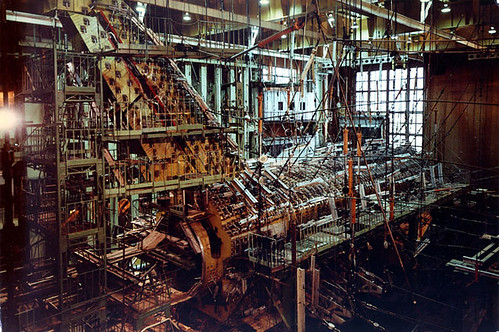 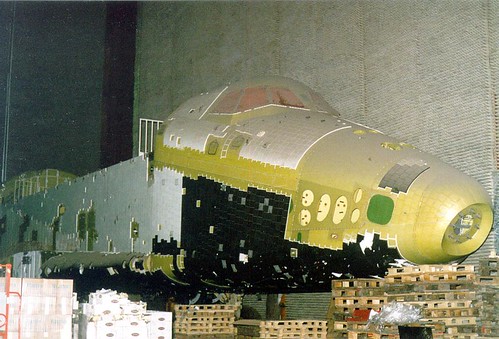 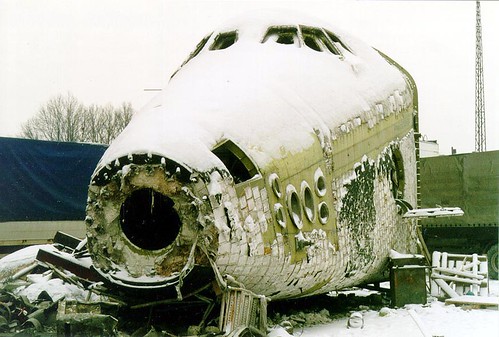 The total spending on this program amounts to $16-17 billion dollars. At least one of the shuttles is used for vibration testing at TZAGI Institute:  The slogan in this picture says "Work with Inspiration", and truly, there is something grand, noble and inspiring in the best efforts of the army of engineers, scientists and pilots, even though the fruits of their labor is seemingly lost. Permanent Link...  Category: Technology,Space Related Posts: Rarely Seen Shuttle Pre-Launch Activities One Day in Space |
RECENT ARTICLES:

|
Visual Caffeine #8 Visual Caffeine, Issue 8 A thrilling blend of art, myths and technology |

|
Visual Caffeine #7 Visual Caffeine, Issue 7 A thrilling blend of art, myths and technology |

|
Art Deco Imperial Dreams: Art Deco Update Wings, Gears, & Glamorous Ladies |

|
1970s SciFi DRB Pics-of-the-Day Grand Space Adventure 1970s Art |
"Dark Roasted Blend" - All Kinds of Weird and Wonderful Things, Discovered Daily!"
DRB is a top-ranked and respected source for the best in art, travel and fascinating technology, with a highly eclectic presentation. Our in-depth articles in many categories make DRB a valued online magazine, bringing you quality info and entertainment every time you visit the site - About DRB
Connect with us and become part of DRB on Facebook and Twitter.
YOUR COMMENTS::
|
|
|
|
SF ART & BOOK REVIEWS: Don't miss: The Ultimate Guide to NEW SF&F Writers! Fiction Reviews: Classic Cyberpunk: Extreme Fiction Short Fiction Reviews: Lovecraft's "At the Mountains of Madness" (with pics) New Fiction Reviews: The Surreal Office |
READ OTHER RECENT ARTICLES:

|
Abandoned, Dieselpunk DRB Pic-of-the-Day Abandoned: Streamlined Three-wheeler |

|
Visual Caffeine #6 Visual Caffeine, Issue 6 A thrilling blend of art, myths and technology |

|
Visual Caffeine #5 Visual Caffeine, Issue 5 A thrilling blend of art, myths and technology |

|
Hellish Weather on Other Planets
Wild, Untamed, and Uncut |

|
Medieval Suits of Armor
Metal Body Suits vs. Weapons of Medieval Destruction |

|
World's Strangest Theme Parks
Amusement to the (twisted) extremes! |

|
Enchanting Victorian Fairy Tale Art
"Then world behind and home ahead..." |

|
Adorable Pedal Cars
Collectable Pedal Vehicles Showcase |

|
Japanese Arcades: Gundam Pods & Other Guilty Pleasures These machines have gone up to the next level |

|
Modernist Tallinn Architecture Delicious blend of old and new! |

|
Early Supercomputers: A Visual Overview "Computers in the future may weigh no more than 1.5 tons" |

|
Futuristic Concept Cars of the 1970-80s French, Italian & Japanese rare beauties |

|
Epic 1970s French Space Comic Art DRB Time-Slice: Valérian and Laureline |

|
The Trees Are Escaping! The Abandoned Prison in French Guiana "Great Escape" from the Devil's Island |
|
FULL ARCHIVES (with previews, fast loading): 2022/16 2015/14 2013 2012 2011 2010 2009 2008 2007 2006 Link Lattes Feel-Good & Biscotti Issues |
|
CATEGORIES:
Feel-Good! | airplanes | animals | architecture | art | auto | boats | books | cool ads | famous | futurism | food
gadgets | health | japan | internet | link latte | military | music | nature | photo | russia | steampunk
sci-fi & fantasy | signs | space | technology | trains | travel | vintage | weird | abandoned













































39 Comments:
More pictures and explanations in english can be found here.
This was wonderfully entertaining to read through!
About the similarities in the design. To my knowledge the space shuttle design itself was never classified. I remember hearing an interview with a NASA engineer who stated that if the Russians had asked for the schematics they probably would have been given them.
I wish this was still in use. the entire system is more capable than the space shuttle and can lift more into orbit.
All similarities end after external appearances. The main point of difference is that Space Shuttle is TWO-stage rocket -- first stage are solid boosters, while second stage is an orbiter itself. Buran-Energia is a three-stage rocket, Energia being a complete independent heavy-lift booster in the same class as Saturn V. Orbiter is just a payload (or a third stage at most), and could be lifted to LEO without ever engaging its engines, which are much smaller and less powerful that Shuttle's ones. It had much more sophisticated avionics compared to early shuttles, as it could land automatically, and it was also equipped with ejection seats for all of crewmembers -- something that Challenger crew would sertainly wish they had.
khathi is essentially correct. The Buran was a principally different vehicle, similar in appearance only. It is significantly smaller the the Shuttle as well. To call the Energia a launch vehicle in the same class as the Saturn V is technically correct but deceptive. The Saturn V had a design capacity of 200 tons to LEO (It actually lifted 156 tons to LEO with Apollo 17.). I think the Energia could manage just over 100 tons. Still, I don't mean to belittle the Energia. It is an impressive launch vehicle. But it is unlikely the Saturn V will be topped any time in the near future.
>> This "Buran" is mothballed in
>> storage, most of the others are
>> effectively destroyed.
It no longer exists either. The roof collapsed on it back in 2002.
khathi: ejection seats would not have helped the challenger crew - they (still) would have been incinerated at the speed they were traveling.
Well, Saturn V COULD've been topped -- if the whole Energia-Buran project wasn't scrapped, that is. You see, Energia was a highly scalable design, and you could've easily bolt up to a four additional fist stage boosters (IIRC, some of the pics even show this config, sadly, it was never really flown) effectively doubling its capacity -- up to 175 tonnes. But you are right, LEO capacity for standard config was just 100 tonnes, 20 tonnes less than for Saturn V (which could lift just 120 tonnes to LEO, not 200).
Another point -- the orbiter that was destroyed in 2002 was OK-1K1, the very same that was flown in 1988. Another one, OK-1K2, one that should've fly manned mission, was never completed and is still mothballed in Baikonur, IIRC.
Objection! Crew capsule remained intact after orbiter disintegration, and remained intact (and crew alive, albeit with at least several crewmembers inconscious) until the final strike into the water. Had it been equipped with ejection seats, crew could safely eject during "drop" phase.
I am sorry to disappoint you, but the Baikal story is a well done 1st April joke, by Vadim Lukashevich, the webmaster of buran.ru - the most comprehensive website on Buran project.
There were advanced plans to improve the Saturn V as well. One was to stretch the tanks and add a sixth main engine for a total of 9 million pounds of lift-off thrust. Another was to add solid, strap-on boosters. Yet another of the more ambitious proposals was to separate the main engines from the tanks and parachute them down for re-use. I actually knew one of the engineers who helped develop the F-1. He said that the only reason the engines were not re-useable was because they were at the bottom of the Atlantic. The engines were actually designed to be able to be used five to seven times. But, alas, so many good ideas never to be tried. Sigh.
Can't view the pictures in their original form, Flickr just says private page. Any chance of a fix? Cause these are great.
Fedor... images fixed
"khathi: ejection seats would not have helped the challenger crew - they (still) would have been incinerated at the speed they were traveling."
According to:
http://www.aerospaceweb.org/question/investigations/q0122.shtml
The Challenger was at 46,000 ft travelling at 1.9 Mach when the disaster struck.
According to:
http://space.newscientist.com/article/mg14920124.300-please-keep-your-seat.html
The Zvezda K-36 ejection seat of the Buran allows cosmonauts to eject at 30Km (98,000 feet) and 4 Mach.
Columbia disaster... that's another story.
Thank you for the pics. I've been fascinated by space ships since I was a child and this is the first time I see Buran from inside. So I'm very grateful :)
''Pre-launch moving of "Buran" and "Energia" on rails''
The last two photos are of Proton, not Buran or Energia.
Proton is a much smaller rocket (A medium one). You can also see the 6 outer tanks and 6 engines attached to them, no central engines, very different from Energia's 4 boosters and 3 core engines.
I'm surprised nobody noticed yet.
Proton is a sixties design, still flying today, commercially, although they just had one launch failure with the second stage just after staging.
Great collection, to add:
Ultimate Buran collection area on NASASpaceflight.com is here:
http://forum.nasaspaceflight.com/forums/thread-view.asp?tid=636&start=1
and on their L2 section they have hours of never before seen video.
On early Soviet shuttle concept TM pic:
Twin-tail space shuttle, two stage to orbit:
the perennial favorite of Popular Science magazine covers.
The only thing missing is a wheel-shaped space station.
Note what appears to be a flight engineer behind the cockpit,
and either a political officer or a flight attendant in the next
compartment.
I remember sitting infront of the TV and watching the launch of Buran/Energija live!
I was a small boy at that time (from former GDR, east germany) and it was a huge event for me...
Yoy may be interested in the end of the Buran story: The last prototype has been discovered by a television team somewhere in Bahrain back in 2004. These days, it is on its way to a museum in Germany. Some pics can be found here: http://www.spiegel.de/wissenschaft/weltall/0,1518,546884,00.html
hb - great link, thank you!
One reason they might have decided to have it horizontal when transporting to the launchpad is that it's possible to accelerate much faster. The angular momentum on an already erected rocket is so much greater that any acceleration beyond a bare minimum risks damage or even toppling the rocket.
One of the Buran's was stored for a couple of years in a shipping yard in Bahrain (Persian Gulf). I was visiting the yard and saw a space shuttle type of craft, found later on the internet that it was one of the Buran's. The wings where taken off but you could enter the Buran trough a opening in the hull. Took home one of the smaller panels from the cockpit as a souvenir.
Last thing I heard that is will be transported to a museum in Mannhein, Gemany.
Martijn(Netherlands)
The 'German museum' mentioned here several times, is the Technik Museum, and the Buran is shipped to the Sinsheim location of the museum. See http://www.technik-museum.de.
Correction, that should be the Speyer location of the Tecknik Museum...
Martjin, Daap - I'm glad it's in the good hands now.
One of these shuttles is in Australia. It was at the worlds fair, and the russians didn't have the cash to fly it home. So it still sits there to this day.
Anon, the one that was in Australia -- it's the very same that finally arrived in Germany some time ago. The company couldn't make profit by using it as an attraction, so they've shipped it to warehouse in Bahrain and just let it sit there.
Regarding the Shuttle and ejection seats, there *were* ejection seats on Columbia, for her first few flights, before the system was considered flight-qualified. There were two ejection capsules, similar to those found on SR-71 Blackbirds, and intended for use if the vehicle was nearly finished with its reentry and about to ditch -- a landing off of a runway is not considered survivable.
But they're problematic. For one thing, they are very heavy. For another, you need a path for the ejection seats to take. For structural reasons, that could only be provided for commander and pilot. It is simply not done to have ejection seats for only two of the crew, so once the crew grew above two, the ejection seats were deactivated and eventually removed. No other Orbiter had them but Columbia.
Would such seats have saved the Challenger crew? Forgiving that they could only have been effective for CDR and PLT, it is still by no means clear that a safe ejection could have been achieved. Most likely, they would have ejected directly into the fireball. And it's not a flight regime where you'd ordinarily want ejection seats -- in all other failure modes, ejection seats during a Shuttle launch will be fatal.
It's not as clear as it might seem. Wayne Hale (former Shuttle program director) has a fascinating series of posts on Black Zones in his blog that goes into this problem in more detail.
http://blogs.nasa.gov/cm/blog/waynehalesblog/
One more thing -- there are some very cool pictures in there. Two are of Proton rockets, unrelated to Energia-Buran but to this day, the heavy-lift workhorse of the Russian rocket fleet. More interesting are the pictures of what I presume to be Polyus, the payload of the "other" Energia launch. Energia flew once without the Buran. It carried a space station called Polyus on its back. Little is known about it, as it was a military flight. It may even have been nuclear powered. What *is* known is that although the Energia performed flawlessly, Polyus' own engines failed to inject it into the proper orbit, and it ended up in the Pacific Ocean. Very sad.
One piece of Buran-related hardware did eventually fly: a docking compartment for Mir. It was modified with Apollo-Soyuz Test Project unisex docking adapters and installed on Mir by the Space Shuttle Atlantis. The newly-constructed Orbiter Docking System was designed to mate with it, and it was used throughout the Shuttle-Mir program. Its legacy lives on in the ODSes in each surviving Orbiter, and in the Pressurized Mating Adapters aboard the ISS.
Calli - great info, really enjoyed it. Will include more interesting shots in Part 2.
Actual the engines of the Saturn V will probably be used in the successor of the space shuttle.
In regard to the Control Panel, those are what all Space Shuttle controls look like. It's not necessarily old, it just looks old.
Calli, Polyus was a Prototype Unmanned Laser Battlestation. Gorbachey didn't even know what it was till he showed up for the launch and was then briefed on what it really was. Since he was then trying to shoot down the US's SDI program diplomaticly and publicity wise ... the USSR suddenly having an on orbit working example would have been *Bad*. Especally since he knew the USSR's ecconomy couldn't support building a full on orbit presence that the system would require. Also, the Polyus's engines didn't fail to inject it into orbit. Since the Polyus was, for engineering and/or aerodynamic reasons, mounted with it's tail section forward. The Polyus's RCS failed to stop it's reorintation at 180 degrees but let it spin a full 360 degrees before it's engines fired and did a dandy job of aborting the mission into the Pacific.
mz, moving the rockets out of the assemblly hall to the launch pad horizontly has been the way the USSR/Russians have always done it. All their infrastructer is based around it. When, or if, they ever looked at vertical intergration and rollout it most have not made sence to them since they believe firmly in the engineering proverb "If it ain't broke, don't mess with it".
El VentureStar sí que era un lanzador revolucionario. Deberían volver a trabajar en él.
awesome photos! also woth noting that the Antonov Ukrainian built carrier plan is actually bigger and with larger payload capacity than the airbus A380 - a pretty impressive achievement too!
I never saw those photos of the being-built Buran before, almost brings a tear to my eye. Makes you wonder how many 100s of billions did the Russians waste on this and other programs as you can see from other 'closed' projects. Some part yes they are not wasted as it helps tech research, but all that money spend to build the storage, superstructure, etc etc wow sad
'Climb inside to experience rickety-looking Soviet computer panels and monitors.
It takes guts to fly into space with these...'
Rickety-looking?! The smug condescension, so typical of writers in the decadent West, towards anything and everything associated with the Soviet Union, is sickening. What, exactly, is 'rickety-looking' about it? Be specific, I want technical details here, not just another 'oh, look, analogue instrumentation'! (By the way, analogue dials are in no way that truly matters inferior to fancy LCD screens; they just represent different approaches to the display of information).
Need I remind you that, at this moment in time, the United States doesn't even have a manned space programme, whilst the only space station in orbit is serviced by (surprise, surprise) cosmonauts. The U.S. shuttle fleet was extremely expensive and accident-prone, whilst the Soviets abandoned their own shuttle programme because they realised that the current Soyuz system was more than adequate for the tasks they had in mind.
The Soviet philosophy regarding space travel has always been 'if it works, and works well, stick with it'. They have never been obsessed, as those in the West obviously are, with all of this flashy 'state-of-the-art' nonsense, their understanding that the constant and continual push to 'upgrade' creates an ever-more costly and bug-prone (and yes, 'rickety') space-transportation system.
Well said Peter! The stereotype is sickenning. Great post and amazing blog but dont do this BS biased writing. Please
Post a Comment
<< Home